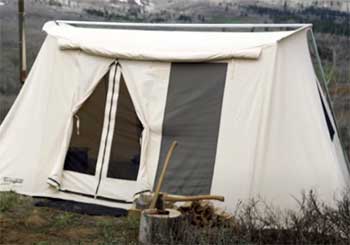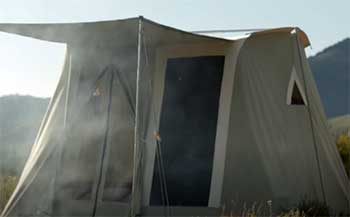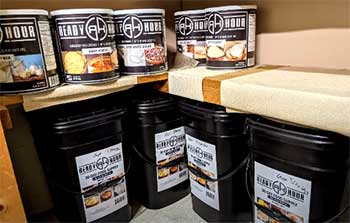For over 70 years, Springbar tents have been synonymous with quality and durability in the camping world. Two of their most popular tent models are the Classic Jack and the Highline.
These iconic tents share some similarities but also have key differences that may make one model a better fit depending on your camping needs.
In this in-depth comparison review, we’ll take a close look at the features, specs, pros, and cons of the Springbar Classic Jack and Highline tents so you can decide which model is right for you.
A Brief Comparison Table
| Specs | Springbar Classic Jack | Springbar Highline |
| Tent Type | Dome | Modified dome |
| Tent Material | 18 oz cotton canvas | Polyester ripstop |
| Frame Material | Steel | Aluminum |
| Packed Weight | 17 lbs | 9.5 lbs |
| Floor Space | 40 ft2 | 39 ft2 |
| Peak Height | 52 in | 52 in |
| Doors | 2 side, 2 end | 2 side, 1 rear |
| Windows | End windows | Full rear mesh |
| Floor | Waterproof canvas | Taped bathtub floor |
| Set Up Time | <5 mins | <5 mins |
| Weather Resistance | Excellent when weathered | Very good with rain fly |
| Headroom | Excellent | Good |
| Durability | Extremely high | Excellent |
| Cost | Around $500 | Around $500 |
Overview of the Springbar Classic Jack
The Springbar Classic Jack is one of Springbar’s original tent models that helped launch the company in the 1950s. This dome-style, canvas tent has a timeless design made to withstand decades of camping.
Some key features and specs:

- Material: Cotton canvas over a steel frame
- Packed Weight: 17 pounds
- Floor Space: 40 sq ft
- Peak Height: 52 inches
- Doors: 2 side doors with inside mesh, 2 end windows
- Floor: Seamless and waterproof
- Frame: Steel with side spreader bars for stability
- Pros: Extremely durable, spacious interior, sets up in minutes
- Cons: Heavy, canvas requires weathering
This tent has a simple dome shape with nearly vertical sidewalls to maximize interior space.
The heavy 18 oz cotton canvas is naturally water and mold resistant. It needs to be weathered before first use to tighten and shrink the fabric. Once properly weathered, the canvas becomes highly waterproof.
The Classic Jack frame is made of high quality steel with thick diameter poles at the corners for strength. Guy lines and side spreader bars improve stability in windy conditions.
This tent sleeps two comfortably and is easy to set up – no poles to thread! It can work for car camping or short backpacking trips if the weight is split between two people.
Overall, the Classic Jack is built to last a lifetime. The heavy canvas construction makes this tent extremely durable and ideal for long term use.
Overview of the Springbar Highline
The Springbar Highline is a modern, lightweight version of the classic Springbar tent design. This popular tent combines the durability and livable space of traditional Springbar tents in a lighter package better suited for backpacking.
Here are some of the Highline’s key features and specs:
- Material: Polyester ripstop fabric over aluminum frame
- Packed Weight: 9.5 pounds
- Floor Space: 39 sq ft
- Peak Height: 52 inches
- Doors: 2 side doors and rear window
- Floor: Tub style with taped seams
- Frame: Aluminum with fiberglass pole
- Pros: Lighter weight, fast setup, great ventilation
- Cons: Less headroom than Classic Jack
The Highline uses durable, waterproof polyester instead of heavy canvas. The ripstop weave makes the tent fabric strong yet lightweight.

Aluminum replaces steel for the tent poles, dropping nearly 8 pounds from the total weight.
However, the Highline retains thick poles at the corners for structure. The angled side walls help shed wind and rain.
For ventilation, the Highline has a full-length mesh window along the back rather than a solid fabric wall.
Two zippered side doors and the mesh window allow ample airflow.
While spacious inside, the angled walls and aluminum frame mean the Highline offers a bit less headroom than the vertical Classic Jack design. However, the Highline provides nearly the same floor space while shaving off a significant amount of packed weight.
This makes the Highline a more viable 3-season backpacking tent option compared to the Classic Jack. It retains Springbar’s quality craftsmanship in a lighter shelter.
Key Differences Between Springbar Classic Jack And Highline Tents
- Weight and Packed Size
One of the biggest differences between these two tents is their weight and packed size.
The Classic Jack is built with heavy duty materials to withstand years of camping trips. The cotton canvas and steel frame make this tent quite heavy at 17 pounds.
When packed down, the Classic Jack measures 30 x 7 inches. The entire tent can fit in an elongated stuff sack that’s easy to strap to the top of your pack or store at camp.
Meanwhile, the Highline uses more lightweight yet durable materials with its ripstop polyester fabric and aluminum frame. This trims the weight down to just 9.5 pounds – nearly half the weight of the Classic Jack!
When packed, the Highline is slightly smaller at 24 x 7 inches stuffed into its carry bag. The lower weight and pack size make the Highline much easier to carry for longer distances or multi-day backpacking trips.
So if you plan to move camp frequently or hike farther to your campsite, the lighter Highline design has a clear advantage over the Classic Jack. But if you prioritize durability over weight and don’t mind a heavier pack, the Classic Jack may be a better choice.
- Weather Resistance
Both of these tents offer good weather protection thanks to their durable fabrics, quality frames, and waterproof flooring. However, the type of fabric makes a difference in their weather resistance.
The Classic Jack is built with long lasting, naturally weather resistant 18oz cotton canvas. Untreated canvas is not fully waterproof, but it does shed rain well when properly pitched at an angle. It may sag a bit when wet but tightens back up when drying out.

The canvas requires weathering before use by setting up and spraying down a few times.
This shrinks the fabric to make it fully water tight.
Properly weathered canvas won’t leak except in the most severe rainstorms.
The Highline uses lightweight yet abrasion resistant polyester ripstop.
While not as robust as canvas, the poly ripstop fabric stands up well to wind, rain, and UV rays.
The floor is made of heavier duty polyester with taped seams to prevent water intrusion.
The Highline relies more on factory DWR coating to make the fabric waterproof compared to the Classic Jack’s thick, naturally weather-resistant canvas. However, both tents keep you dry in most conditions if used with a rain fly or tarp.
Overall, the Classic Jack may have a slight edge for long term water protection thanks to its heavier canvas material. But both tents provide good shelter from the elements in the backcountry when pitched correctly.
- Livability and Interior Space
A good tent needs to have enough room to sleep and store gear comfortably. So how do these iconic Springbar models compare when it comes to interior space and livability?
The Classic Jack feels roomy inside thanks to its near vertical side walls and spacious dome layout. Two adults can sit up comfortably inside this tent. There’s also plenty of space to keep packs and other gear out of the way by the doorways.
However, the crisscrossing spreader bars do obstruct living space a bit. You have to duck under them to move about the tent interior.
In the Highline, Springbar opted for more angled side walls to improve weather protection and save weight. This does cut down a bit on overall headroom. Tall campers over 6 feet may find it lacks the same spacious feel as the vertical Classic Jack design.
But the Highline provides nearly equal floor space at 39 sq ft. So two sleeping pads and bags fit comfortably with some room to spare for gear storage. There’s also greater usable space since the Highline lacks cross bars bisecting the interior.
Both models offer good ventilation with large mesh doors for airflow. However, the Highline’s full mesh back window provides even better air circulation on hot summer nights.
So while the Classic Jack technically has higher peak height at 52 inches, the Highline’s open layout and ample mesh allow it to match the Classic Jack for livability. Just don’t expect to stand up fully inside the Highline like you can in the Classic Jack.
- Ease of Setup
Springbar tents are known for their quick, simple setup thanks to their sturdy frame assembly. Both of these tents can be fully pitched in under 5 minutes once you get the hang of it.
The Classic Jack sets up with a sleeve and pole design. You join the corner poles together through a sleeve that runs over the tent roof. There are no individual pole segments to thread piece by piece, making setup a breeze.
Stake down the corners, attach the side spreader bars, and it’s ready to be guyed out. The whole operation takes just a couple minutes.
The Highline uses a very similar construction but with longer aluminum poles that join in the middle. You manually feed the poles through sleeves in the roof panels to form the frame. While not quite as fast as the Classic Jack, it’s still quicker than most typical backpacking tents.
Both tents use clips to connect the fly to the frame once pitched. The Classic Jack has guy lines pre-attached while the Highline uses detachable guy lines.
Overall, the Classic Jack gets top marks for easy setup thanks to its sleeve-and-pole assembly. But the Highline isn’t far behind. Both tents remove the headache of threading lots of individual poles, unlike many dome-style tents.
- Durability and Longevity
When buying a premium tent, you want it to hold up for many seasons without needing frequent repairs. This area is where Springbar tents really stand out from the competition.
The Classic Jack is built for the long haul. Its hefty 18 oz canvas stands up to years of regular use without degrading. The material will fade with sun exposure over time but remains waterproof. And the thick steel frame shows no signs of bending even in high winds.
Every component of the Classic Jack is overbuilt for lasting performance. Even if a piece were to eventually break or wear out, replacement parts are inexpensive. Its simple, classic design guarantees you can keep this tent pitching for decades.
Similarly, the Highline doesn’t skimp on durability despite its lighter weight. The polyester ripstop fabric resists tearing better than standard tent nylons while the aluminum frame feels nearly as sturdy as steel.
Springbar also offers replacement parts for the Highline so you can repair any component if needed. Reviews show the Highline holds up well over many seasons of regular camping use with only basic upkeep.
Both of these tents are backed by Springbar’s stellar reputation and lifetime guarantee against defects. So while no tent will literally last a lifetime, these two models come as close as you can expect. The Classic Jack and Highline are both a long term investment in a quality, lasting shelter.
Also Read: Comparison of Kodiak And Teton Canvas Tents.
- Cost and Value Comparison
With either tent priced around $500, the Classic Jack and Highline carry a premium price tag. Are they worth the higher cost compared to budget backpacking tents?

In a word – absolutely.
You’d spend that much replacing cheap tents every few years after they fail in the field.
The Springbar’s superior materials, craftsmanship, and longevity provide excellent value over the tent’s lifetime.
Between the two models, the Classic Jack may have a slight edge in value for the money.
Its canvas fabric and steel frame make it virtually indestructible – you’ll hand this tent down to future generations of campers.
So the higher cost gets balanced out by decades of use.
But the Highline still carries Springbar’s reputation for quality at a lower price point. Despite the lighter materials, Springbar doesn’t cut corners on durability and components. So you get a slightly more affordable price without losing the Springbar standard of excellence.
While not cheap, investing in the Classic Jack or Highline means you likely won’t need to buy another tent for a very long time. Considering the cost per use over 10+ years, both models provide outstanding value compared to cheaper tents.
Which Tent Is The Best Fit For You?
After comparing the Classic Jack and Highline models, how do you decide which tent better matches your needs? Here are a few key questions to help determine the right fit:
- Will you carry the tent long distances or need ultralight packability? Go with the 9.5 lb Highline.
- Do you camp in exposed alpine areas or coastal environments? The Classic Jack handles severe weather better.
- Are you taller than 6 foot? The added headroom of the Classic Jack makes it more comfortable.
- Is durability or longevity most important to you? The Classic Jack is tougher and will last longer.
- Does added ventilation matter for where you camp? The Highline’s mesh window offers superior airflow.
- Is saving weight more important than maximizing interior space? The Highline saves pounds.
- Will you mainly car camp or backpack occasionally? The extra weight of the Classic Jack won’t be an issue.
Also Read: Differences Between Coleman And Kelty Tents.
Frequently Asked Questions (FAQ)
Springbar tents was originally founded in 1951 by Herbert Swanson in Salt Lake City, Utah. The brand changed ownership in the 1990s. It is currently owned by Allies Ltd, Co. which continues to produce Springbar tents in Salt Lake City.
The Springbar Highline 6 tent has a minimum weight of 9 pounds 5 ounces and packs down to a trail size of just 7 by 24 inches. This makes it one of the lightest and most compact Springbar tent models.
Springbar tent weights vary by specific model. On average, most Springbar tents weigh between 9-17 pounds. Some of their lightest tents include: Highline 6: 9 lb 5 oz, Alpine 6: 9 lb 10 oz, Scout: 8 lb 10 oz. Some of Springbar’s heavier, more durable tents include: Classic Jack: 17 lb, Hampton: 15 lb 4 oz, Alaskan: 14 lb.
The Springbar Vagabond is one of their most spacious tent models. Key dimensions include: Floor area: 100 square feet, Peak height: 72 inches, Packed size: 10 x 33 inches, Weight: 19 pounds 5 ounces.
With two side doors and two end doors with awnings, the hexagon-shaped Vagabond sleeps up to four campers comfortably. The near-vertical walls provide lots of headroom and livable space.
Final Thoughts
The ideal tent choice comes down to your specific needs and camping style. For extended backpacking trips, the Highline saves weight without compromising too much interior space. The added ventilation is also nice for warmer weather.
But for car camping or short backpacking overnights, the extra robustness and livability of the Classic Jack can’t be beat. Its appeal lies in supreme durability and spacious comfort rather than light and fast design.
Either model is hands down a better choice than cheap, disposable tents for serious campers. Buy right – buy a Springbar – and you’ll be set for years of camping adventures.


